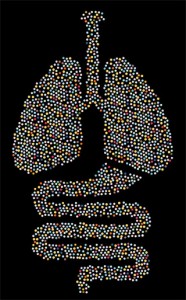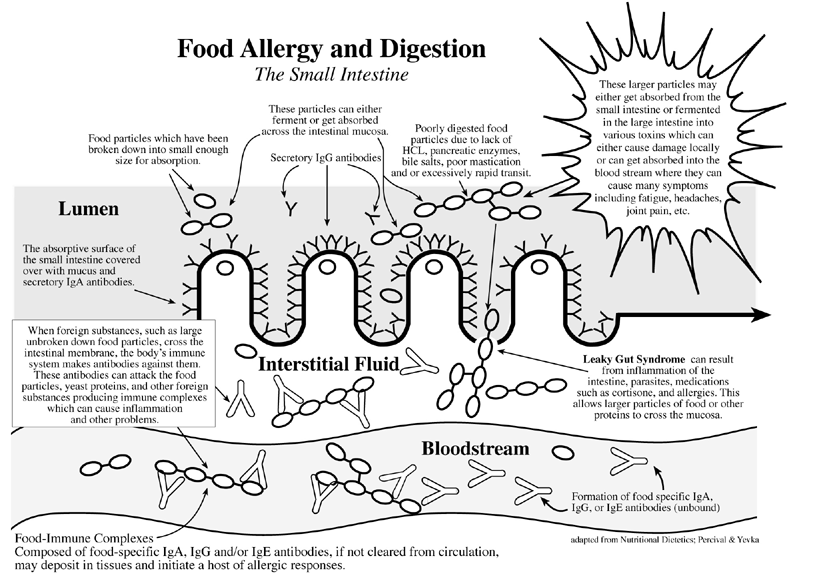Only 10% of the cells in our bodies are human. Ponder that. We  have easily a hundred trillion bacterial cells, not just in our gut but all over our body. They make us work: breaking down food into something we can assimilate, fighting infection, signaling our cellular processes, converting sunlight to Vitamin D, forming biofilms to protect us. We have fungi that break down wastes, yeasts that ferment and transform extra sugars, worms that can prevent autoimmune disease. Some of our bacteria themselves have viruses. We are walking colonies of organisms in a human superstructure.
have easily a hundred trillion bacterial cells, not just in our gut but all over our body. They make us work: breaking down food into something we can assimilate, fighting infection, signaling our cellular processes, converting sunlight to Vitamin D, forming biofilms to protect us. We have fungi that break down wastes, yeasts that ferment and transform extra sugars, worms that can prevent autoimmune disease. Some of our bacteria themselves have viruses. We are walking colonies of organisms in a human superstructure.
I was lucky to have attended Berkeley in the ’70s when the theories of Lynn Margulis on evolution from bacteria were taking hold. Margulis holds that we started as colonies of microorganisms which specialized or cooperated with other kinds of colonies to form superstructures we recognize as species. She noticed that brain cells and sperm share characteristics with spirochete bacteria, positing that they evolved from bacteria that were gradually incorporated into the superstructure.
Since the 1880s when the mitochondria that power each of our cells were discovered, scientists have noticed their similarity to bacteria. They have their own DNA and yet live not only inside of our bodies, but inside of our cells and we would have no energy without them. Margulis calls them endosymbionts (“inside symbionts” or “inside organisms that live intertwined with us.”) We are composites of human and microrganism cells: some are totally independent, some form biofilms over our teeth or guts, some are incorporated into the superstructure.
This is true of plants and animals as well. Termites can’t digest wood themselves. It is not their gut bacteria, but the organisms that are symbiotic with the gut bacteria of the termites which can break down the cellulose. Plants have chloroplasts which act like mitochondria and their own microorganisms. Fungi provide a subterranean internet which allows forms of chemical communication throughout a forest.
Although we have some human genes, the microbes together contribute at least 1,000 times more genes to the whole. That is right, your genes aren’t entirely your own either. We use those genes, and they affect the epigenetic expression of our human genes.
The collective term for all your microflora is the microbiota, and it acts like a large organ. The microbiota breaks down food we can’t digest, processes toxic drug residues and filters them out of the nutrients we send to the blood, it makes vitamins that we need and generally protects our immunity. When it suffers an assault, say a course of antibiotics or a very bad diet, we get sick, just as we would if our lungs or liver were assaulted. We need to care for our symbionts.

Parts of the natural health community has expressed fear of the larger symbionts- witness the rush to kill off “parasites.” Our immune systems have co-evolved with parasitic worms—living alongside then for millions of years has shaped the way our immune systems react to pathogens. We have five interleukin genes, which affect the immune system’s response to disease. These genes have evolved to deal with a variety of different pathogens, including viruses, bacteria, fungi and worms. Yet when the body has no parasites, none of the minor worms that have co-evolved with us, the part of our immune system that would attack the parasites attacks us instead, causing autoimmune diseases that are not present in areas of the world where people must deal with worms. And in fact there have been trials where providing benign worms to people suffering from asthma or Crohns has resolved the condition.
The gut is home to some hundred trillion bacteria, as well as other microbes, providing a living wallpaper to protect your body from irritating proteins or pathogens that come in with food. There are two major classes: firmicuites which include lactobaccili like acidophilus and bacteriodetes which include nonpathogenic varieties of E. coli. Fat and thin people have different balances of firmicuites and bacteriodetes, according to recent research by Ley and Gordon. Fat people have more firmicuites which help break down sugars and extract nutrients from food better.- we get more out of our food whether we need it or not. Thin people have more bacteriodetes which in overgrowth can cause diarrhea. The researchers were able to induce obesity in lean germ-free mice by implanting the gut bacteria of fat mice. Europeans have been able to get e-coli probiotics, which might assist in weight loss, but the FDA forbids their import into the US. (I tried!)
Bacteria which we associate with disease, like H. pylori which is suspected as a cause of ulcers and esophogeal erosion also help us: H. pylori is associated with lower adenocarcinoma rates. Acidophilus which breaks down food is desirable in the gut but can eat away tooth enamel in the mouth. Fairly benign staph bacteria can outcompete serious bacteria like MRSA which are resistant to drugs and when they are eliminated by antibacterial soaps and sprays, the truly nasty bacteria are left.
So ease up on the antibacterial soap, throw out your Hulda Clarke parasite zapper and only worry about those worms that hurt your health or yeasts which have proliferated out of control because competitive organisms are not keeping them in check. And don’t avoid live fermented foods if you have a candida overgrowth: you want competition for the buggers. Miso, kefir, kombucha, yogurt, buttermilk, olives, blue cheese, sauerkraut, live pickles and kimchee are full of probiotics that can all help reinforce your gut flora. And don’t forget the prebiotic foods like inulin or FOS found in Jerusalem artichokes and onions, dandelion roots or chicory which feed your gut bacteria but cannot be fermented by yeasts.
Sources:
Endosymbiosis: Lynn Margulis http://evolution.berkeley.edu/evolibrary/article/_0/history_24
Ecological and Evolutionary Forces Shaping Microbial Diversity in the Human Intestine http://linkinghub.elsevier.com/retrieve/pii/S0092867406001929
Gut Reaction: Environmental Effects on the Human Microbiota http://www.pubmedcentral.nih.gov/picrender.fcgi?artid=2685866&blobtype=pdf
Immune Gene Evolution May Be Driven By Parasites http://www.dana.org/news/features/detail.aspx?id=22816
The Body Politic http://seedmagazine.com/content/print/the_body_politic/ (picture from this article.)
Gut Bacteria Do More Than Digest Food http://www.hhmi.org/bulletin/aug2010/features/gut_bacteria5.html
See Also:
Swapping Germs: Should Fecal Implants Become Routine for Debilitating Diarrhea?
Chemicals and Obesity: What if if isn’t all your fault?
Why A Parasite Cleanse Can Make You Worse
